The newest fighting game from Arc System Works is here, and we need to have a little sit down about it. If you’ve read 50 Days of Blazblue, you know all about my love for fighting games. I’ve played everything from Street Fighter to Soulcalibur, my recent obsession being of course Blazblue Central Fiction. While I’ve been mostly casual about how I’ve played through the years, these days I’ve been doing something I’ve never really done before: I’ve been queuing up the training montage music, getting in shape, and seeking tougher opponents online.
It was nearly two decades ago I played my first, and last, Guilty Gear title. Guilty Gear X2, “the love of my fighting game life.” I’d played a bunch of stuff prior to it, but I credit Guilty Gear with being the game that really made me sit down and examine how I play fighting games. It’s fitting then that after a fighting game hiatus of over a decade and a half we’ve come full circle back to a Guilty Gear title, specifically Guilty Gear Strive.
Also, who is Ramlethal and why is she so amazing?
 Guilty Gear -Strive-
Guilty Gear -Strive-
Developer: Arc System Works
Designer: Daisuke Ishiwatari
Publisher: Arc System Works
Platforms: PS4, PS5, PC
Price: $59.99 Standard Edition, $84.99 Deluxe Edition, $29.99 Season Pass 1 (included in Deluxe Edition)
Copy Provided By Publisher
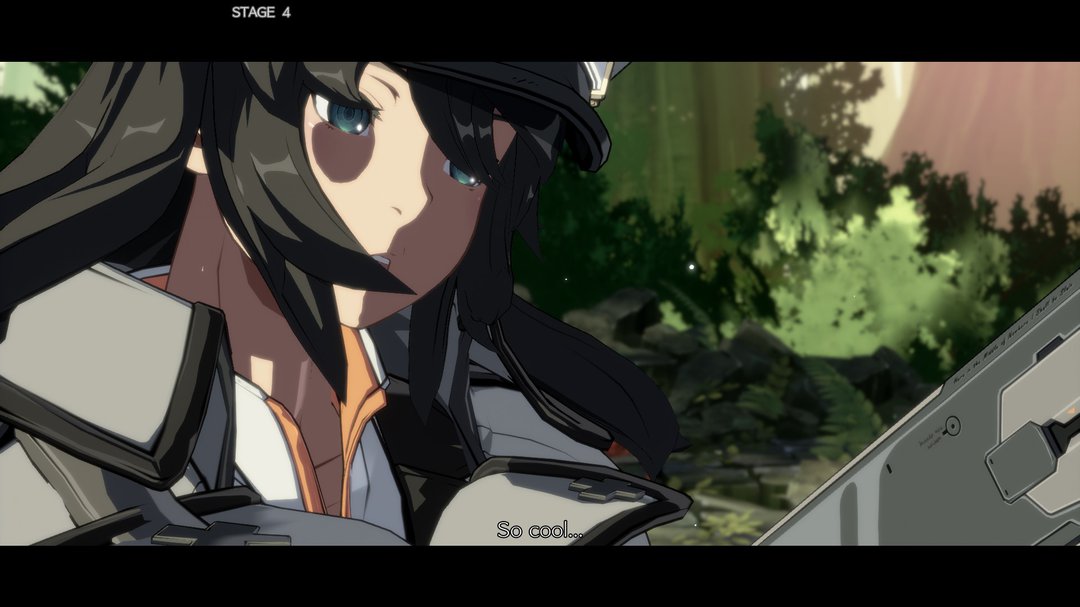
Striving Ever Upwards
When I heard that Strive was on its way, I knew that one way or another I’d be playing it. The series has changed a lot over the years, and I needed to see firsthand just how far it had come. In a word, it’s fresh! Arc System Works has really gone all out in making something top notch here. This feels like a modern Guilty Gear title, from the visuals and animations, to the intense music tracks (seriously every track gets you rocking out), to the way the game itself handles. It really gets your heart pounding, whether you’re facing down a human opponent or buffing up your skills in the Dojo. The music in particular isn’t just a rehash of the same old themes, instead letting you know just how far each character has come in their journey while simultaneously blasting your ears off over the din of battle.
My journey started with a quick cycle through the character select. There were a lot of familiar faces. Sol and Ky still front and center. May and Millia still bashing baddies. Eddie’s name had changed to Zato-1, and that should give you some idea of how much lore I needed catching up on. Thankfully, as if Arc anticipated this barrier to entry, there was a convenient timeline and flow chart included in the “Story” section. I was able to follow through a few infographics, click on a few unfamiliar faces, and before I knew it, I was up to speed on everything that had happened since “That Man” put his plots in motion. If you care about that sort of thing, it’s really nice to know the folks at Arc thought about you.
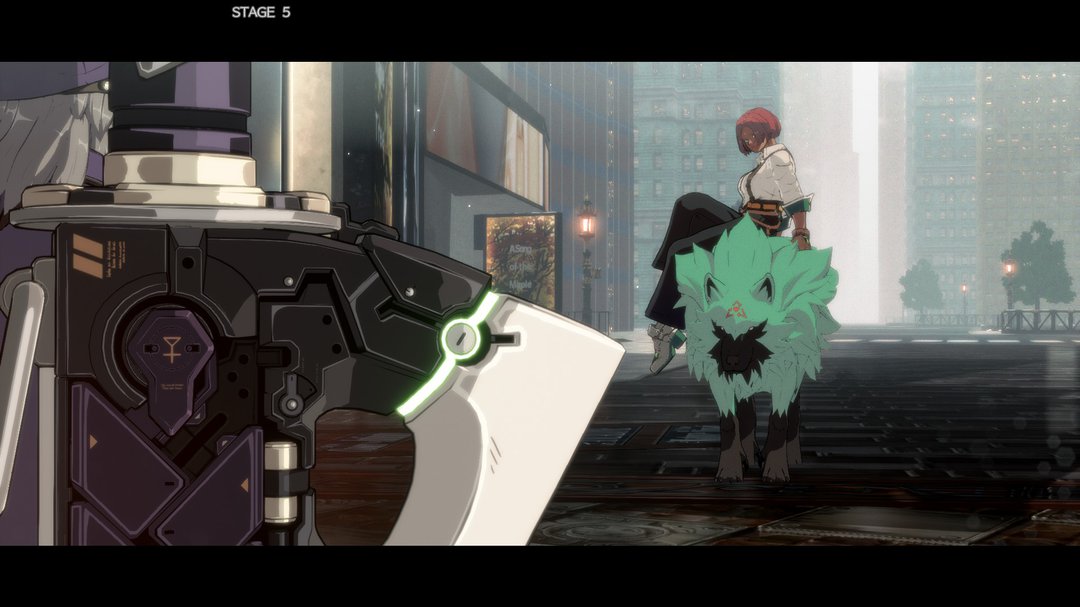
Intro sequences might suffer from a little sameyness, but they're still very satisfying to watch. I hope we get more inter-character specific ones in the future.
Guilty Gear Strive shows off at every turn just how far it’s advanced. It’s got some DNA from prior titles like Xrd, but I also see the refinement we’ve peeked in games like Granblue Fantasy Versus. There’s a cinematic smoothness to the characters as they waltz confidently through their attacks, unleashing flashy overdrives and blasting opponents around the screen. It’s more than just the latest title in the Guilty Gear series. It’s the culmination of everything Arc has learned from each game it’s released over the years, given form in perhaps its most beloved of settings. To say even watching this game being played is enthralling is an understatement in the truest sense of the word.
As for me? I tried several characters before settling in to see just how much refinement had made its way into this shiny newness. None of my old mains were in the series (yet, there’s still plenty of DLC planned), so who to pick? An old familiar face? A complete mystery? There was no Dizzy, no Johnny. In the end I settled on Ramlethal. What can I say? A character coolly wielding two giant, hovering swords holds some appeal.
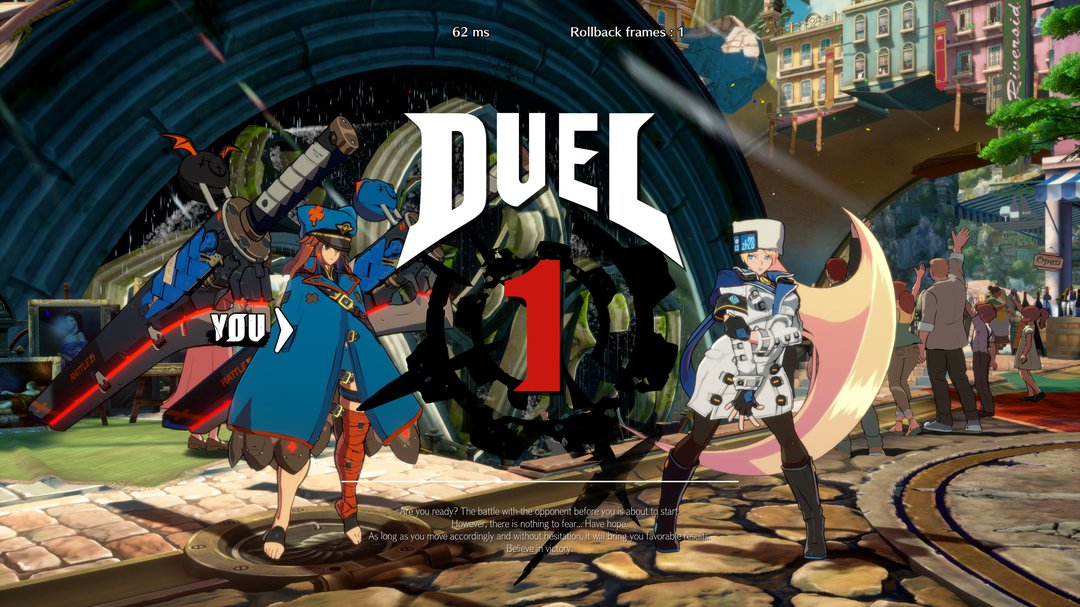
This game is vibrant in all its colors and characters.
Beginner Friendly
Perhaps, like me, you’re returning to Guilty Gear after many years. Or perhaps you’ve always been on the outside looking in, wondering when might be a good time to join. Maybe you bounced off a “less accessible” title like Blazblue and need something that doesn’t require you to memorize twenty hit combos. No matter your entry level, Strive has you covered! Nothing stops you from jumping directly into the online lobbies to learn the painful way, but the first of many shout-outs in my opinion needs to be given to the game’s extensive tutorial/mission system. Strive can teach you everything in as little or as much quantity as you like. Through a series of playable demo lessons, you have access to literally every mechanic the game has to offer.
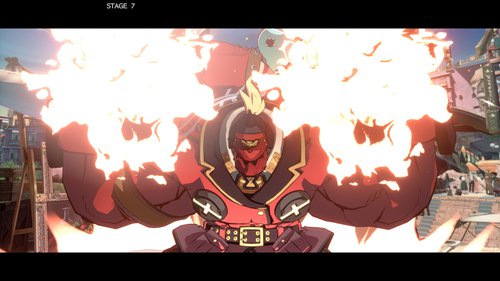
If you’ve never played a fighting game before and don’t know what an air dash is, the game will teach you. It can even help you with the basics of regular attacks, blocks, and movement. If you already know the basics, you can jump straight into the advanced stuff. The game will teach you Roman Cancels in their four flavors, a subtle technique that separates the beginners from the pros; RCs, as they’re referred to by the community, allow you to spend your super meter (tension) to block when you whiff, push an attacker off you, extend a combo past what your moves would normally allow, or link together moves that would normally have too much delay between them. If that’s still old news to you, the game can even launch your thinking into expert territory, showing you how certain moves can slide into others when sharing directional inputs, among other goodies. You’ll soon learn to push your moves to their absolute max, stringing together spectacular chains of pain.
These are only a few examples of ways Strive can help you ease into things or buff up your skills. The mission list is quite extensive, even going so far as to actually explain terms you might’ve heard floating around the fighting game community, like frame advantage or fuzzy jumping. You’ll also be able to download combos that other players share, loading them directly into your Dojo’s practice mode so you can learn new moves without ever needing to visit a YouTube tutorial again. I’ve never seen such a robust training system, capable of visits and revisits that stay relevant as you grow. And honestly, this is a massive selling point in a series that’s always prided itself on being hard to play. This game is almost playful in its welcoming of newcomers, even as it caters to the vets with its subtleties. It’s is easy to get into, but the rabbit hole still shows its signature depth for those that go looking.
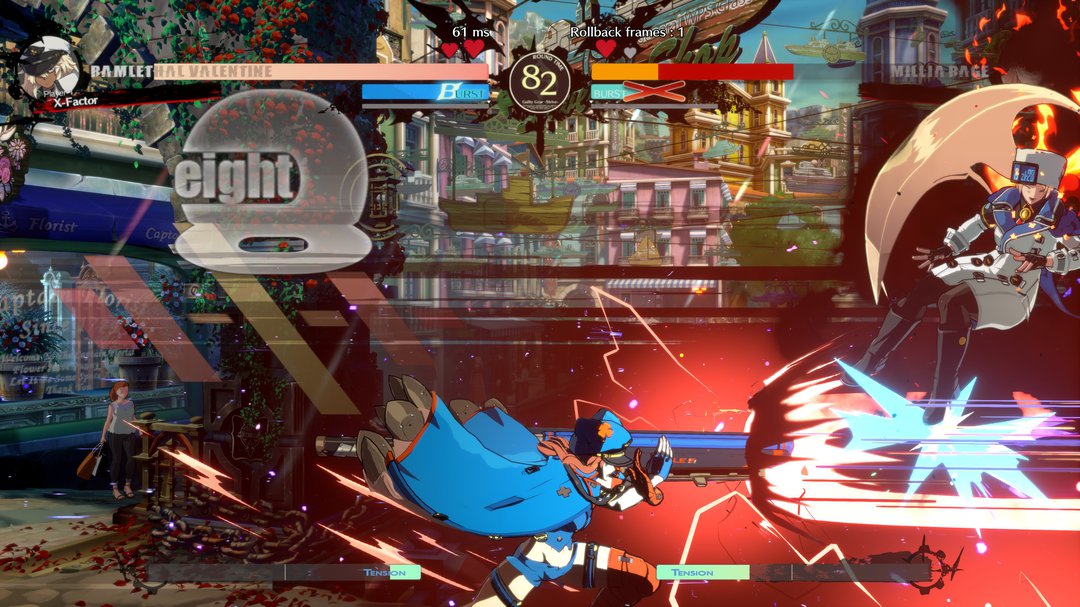
Don't you just hate it when your foot gets shot by a giant laser?
Roll It Back
No discussion of Strive would be complete without talking about its netcode. Can I get away with just saying “it’s brilliant,” because that’s exactly what it is. When it was introduced into an older Guilty Gear title, the community responded by flooding back into its lobbies in numbers to rival currently hot fighting titles. Folks who are familiar with this development have been practically foaming at the mouth over what this means for online matches. The short rundown goes like this: the lag stutters you’re used to in traditional delay-based netcodes are now a thing of the past. If you need more than that, there are some nice videos out there explaining in more detail how it works. Sufficed to say that this is a huge leap up in online match quality from what I’m used to.
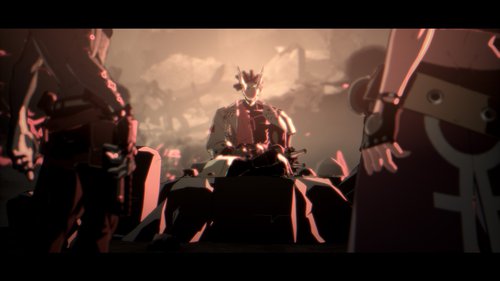
I play in lobbies for East Coast USA, and to date I’ve experienced no major lag in any of my matches within the same region. Occasionally either my opponent is playing on a connection akin to a tuber or perhaps the Strive servers are just getting used to the massive load of players they’re now responsible for, but even then any slight stutters don’t prevent combos or break the tempo of fights. Unlike when lag creeps into my Blazblue matches. Also unlike Blazblue which uses the traditional delay-based code, these instances of noticeable rollback taking visible effect are incredibly rare; most of the time my Strive matches remain buttery smooth, even as the readout at the top of the screen tells me the ping is spiking and the rollback frames are increasing. In Blazblue lag is the rule rather than the exception, and it sees you frequently dropping combos. Not so in Strive.
Just to crank on the netcode a little extra hard for this review, I purposely changed my lobby to Europe to see what would happen. I experienced more visible stuttering mid-match, but again nothing on a level that messed up combos or made matches unplayable. It was really quite impressive just how many normal matches I achieved playing in time zones so much further away, something that would be unthinkable on a delay-based system. Strive was designed with rollback in mind, and it’s clear the outpouring from the community in support of it is immense. I hope my beloved Blazblue Central Fiction will one day be gifted rollback, but in the meantime Strive has no shortage of—well—letting the good times roll!
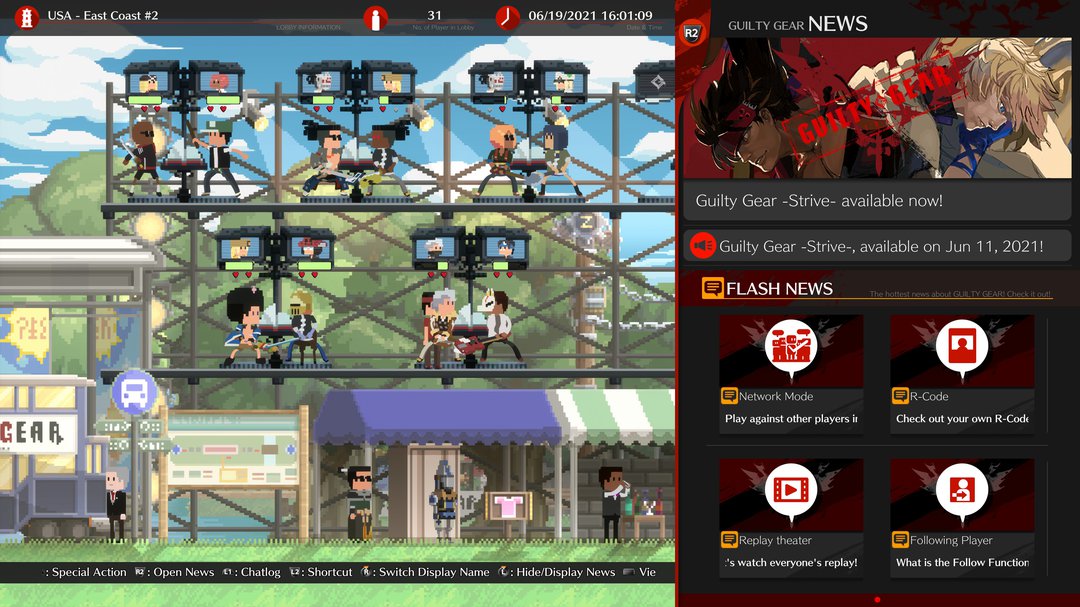
Online lobbies are actually a lot of fun in their pixelated customization. I only wish there was a way to hide the news.
Animetastic
I’m sure most folks who partake of Strive are in it for some combination of cool fighting game + netcode hotness. I don’t know, strictly speaking, if there are any people who buy a fighting game for the story (goodness knows I bought a shooter, Titanfall 2, for the story). Nevertheless, you should know that with your purchase of Guilty Gear Strive you also get a free, full-length anime movie included at no extra cost.
You might think I’m making a hyperbolic joke, but I’m completely serious here. Gone are the days of old where lore junkies experienced story mode with voiced-over renderings of characters sliding like paper cutouts held in front of prerendered backgrounds. Strive’s story mode is an extended cutscene with fully animated characters moving around in 3D. The camera spins and zooms, and character expressions change with the dialogue. The action can be a little bit stiff at times, but the animation on hand is leaps and bounds ahead of the story presentation in prior Arc games. It makes for a very enjoyable break when I don’t want to throw my thumbs against a controller and instead desire some chill time to take in the game’s lore.
I won’t say a ton about the story mode, for spoilers’ sake, other than how well put together it is. It might not be the main focus of the game, but it’s certainly worth the watch. Future DLC even promises to add new stories, if you’re interested in even more lore. The voice acting is solid, the scenes are well shot, and if you’re like me, a lover of the Guilty Gear setting, you’ll find it a great way to see some of your favorite characters do and say more than their limited match openers.
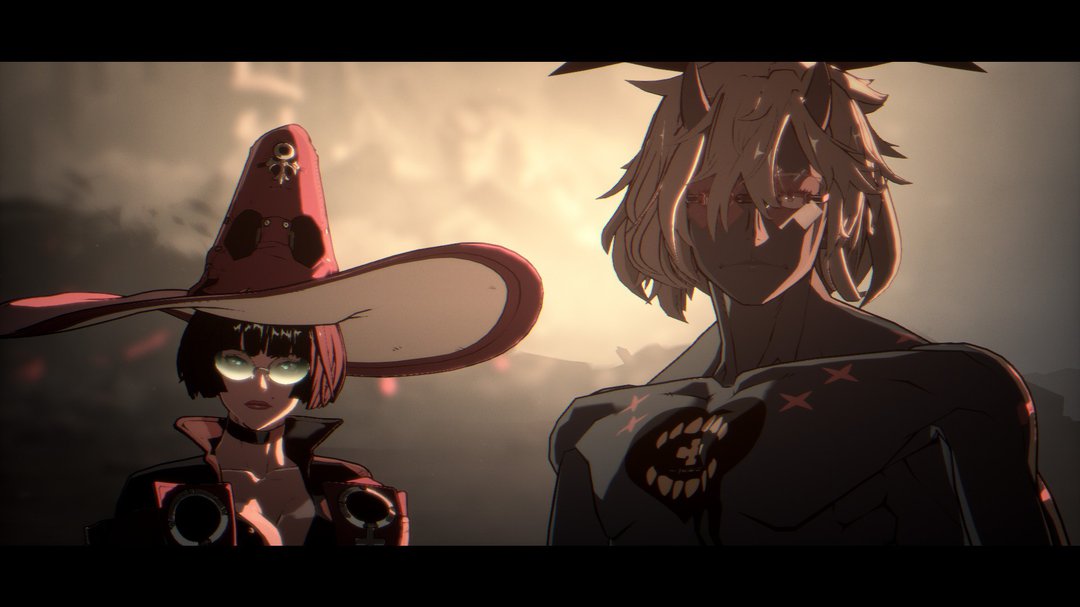
Story mode sees some old favorites return with new faces.
Heaven Or Hell
If you love fighting games, you really can’t go wrong playing Guilty Gear Strive. As reviews go, that’s one of the easiest recommendations I’ve ever made. My bigger concern is for folks who want in on the series or in on fighting games in general. Would I still recommend Strive to them? Despite Guilty Gear’s reputation for difficulty, my answer might surprise you. Yes, I would still recommend Strive to fighting game newcomers, perhaps even moreso than with any other Arc System Works title.
There a little magic in the sweet spot Arc has hit with this game. Somehow they’ve managed to design something that’s accessible to newcomers but loses none of its depth in the hands of pros. Anyone can pick up a character, toss out some special moves, and string together some basic combos. With practice, those same players can learn to RC into larger combos and eventually become so familiar with their favorite characters that they make brand new, deadlier strings that were previously unthinkable. Combined with Strive’s fantastic tutorial system and the stellar online experience, there’s literally never been a better time to play Guilty Gear.
Fighting games will always be a tough recommend between players of widely disparate skill levels, but don’t let that dissuade you. Play with friends. Play the arcade mode. Play the tutorial missions. Play in casual lobbies instead of the ranked ones. Play how you like. If after this review you think this is a game you want to play, then play. The support that Arc promises in the form of new DLC and updated content for Strive means we’re in for one heck of a ride for years to come.